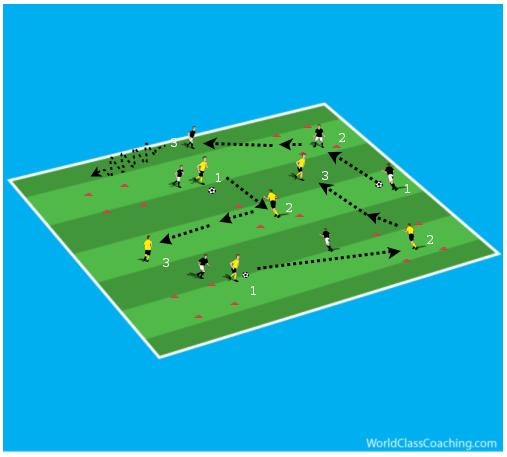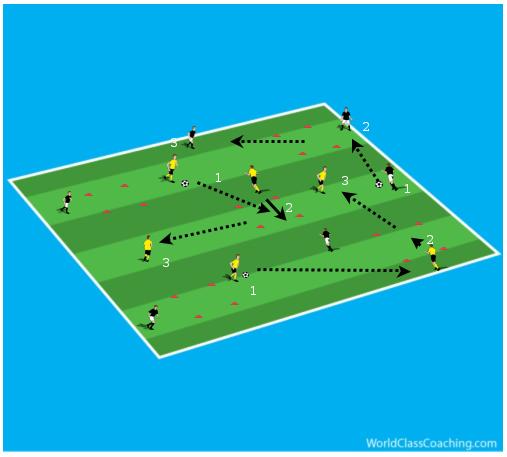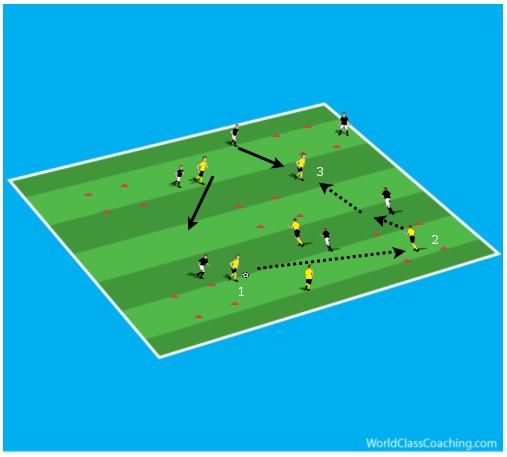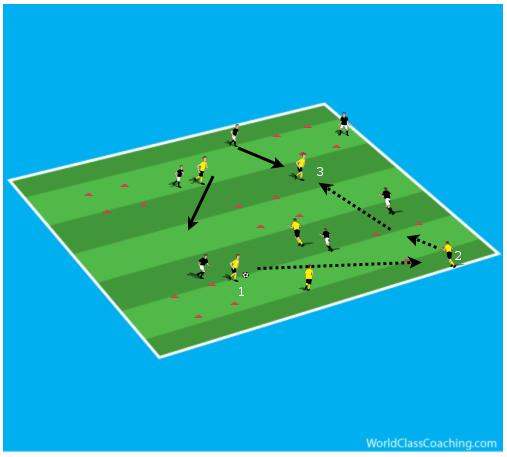By Sean Reed -
The focus of this session is to encourage players to find and use space. Identifying where the space is, the timing of movement to get into the space, the using the ball when receiving in the space.
Objective: Session 1
Working on identifying and using the space when looking to receive the ball. Timing of movement and awareness of next movement once the player has received the ball
 Diagram 1
Diagram 1
Set Up
- The group is split into two teams. Depending on the level of player you can introduce either 1 or 2 balls per team. Within the area there are 5 squares 5x5yds for each square. The size of the squares can changing depending on the objective or level of players you are working with. Obviously reducing the size of area will challenge the players. The number of squares within the grid can be dependant on what the coach wants.
- In the two teams passing between the passing, almost working as a 3, player 1 will pass to player 2 (who must receive in any of the spare grids) their 1st touch must take them out of the grid they will play the pass into player 3 who will be anywhere within the area. Player 3 will then travel with the ball, looking to play player 1 who will receive the ball in any spare grid, to then play into player 2.
- A player can not stand and wait within a square, after a couple of seconds they must come out the square, If another player is already in the square, then that square is no longer free.
- When receiving the ball within a square the player must take their first touch outside the square, but not from the side the ball was received.
- When the pass is played into a small square, the next pass is then played to a player outside the square.
- The number of touches allowed will be down to coach and changing the touches can challenge the players – depending on objective.
Coaching Points
- Awareness of free space (Square)
- Timing of movement into the squares
- Awareness and body shape when receiving the ball in the square
- 1st Touch out side the square and end product
- Communication
Objective: Session 2
The session is the same as session 1, but the player must receive the ball outside the square, for their first touch to take them into the square. Then the player will then pass from in the square. Using the space to take their first touch into.
 Diagram 2
Diagram 2
Set Up
The same set up as the previous sessions, however the players are now receiving the ball outside the square, taking their first touch into the square. As mention within session 1. The coach can start the session off as a handball exercise to get the players understanding the movements.
Coaching Points
- Playing with head up (awareness of other players / space / where & who to play the ball to
- Awareness of free space (Square)
Encourage players to be aware of the space (square) to allow the ball to come across their body without a touch - Awareness and body shape when receiving the ball in the square
- 1st Touch out side the square and end product
- Communication
Objective: Session 3
The next progression is to take this into possession game. Within the game the objectives of using the squares as space to for players to move into and take their first touch into are continued. Obviously with it being competitive it challenges the players awareness, movement and timing. Although we are looking at finding and using space players defending need to track and deny space.

Diagram 3
Set Up
- Going into a possession game. For example, to use the numbers displayed in the diagram 6v6 with 5 squares.
- Unlimited touches
- For a team to score they must make 8 Passes or score with a pass when a player receives in the square, taking their first touch outside the square and then completing another pass into a team mate.
- The number of passes continues even if a goal has been scored with a player receiving in a square.
- Players can only go into a square when their team is in possession and a player cannot be in the square for longer than 3secs.
- Can used as a hand-ball game – especially as a warm-up game
- Please note that by allowing the team in possession to score with a number of passes will encourage the opposition to press the ball, which will then free up the squares
Progressions
- Limit the number of touches
- Change the conditions on the number of passes required to score
- The amount of time depending on the physical objective
- Allow the defending players to occupy a square, but only for 3 seconds
Coaching Points
• Refer to the passing exercises
• Tempo of passing
• Patient in possession – identifying when to play into a player in the square
• Supporting the player in possession
Objective: Session 4
The next stage is to implement within a possession game. Focusing on the link between 3 players, looking at creating that triangle that exists all over the pitch.
 Diagram 4
Diagram 4
Set Up
- The game is set as within session 3. The only difference is the way in which the team can score. The player must receive the ball outside of one of the squares, then take their first touch into a square followed by a completed pass.
- Initially the opposition is not allowed to occupy any of the squares. However, as a coach you can change that ruling depending on whether the players need to be changed.
Progressions
- Limit the number of touches
- Change the conditions on the number of passes required to score
- The amount of time depending on the physical objective
- Allow the defending players to occupy a square, but only for 3 seconds
Coaching Points
- Refer to the passing exercises
- Tempo of passing
- Patient in possession – identifying when to play into a player in the square
- Supporting the player in possession
By Sean Reed
Former First Team Coach of Championship side Fulham FC. Sean is a UEFA A Coach with a Masters in Sport Coaching. He has over 15 years of experience working in professional football from Academy through to First team in the Premiership and Championship.
Linkedin - www.developmentofplayers.com
Twitter - @SeanJReed


